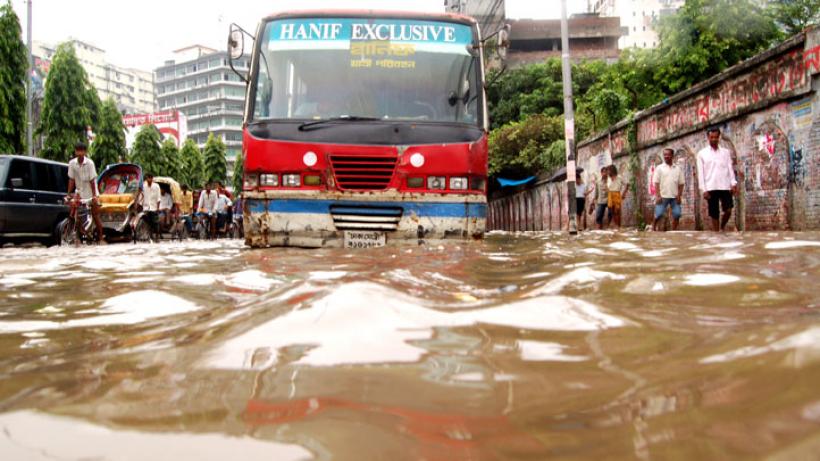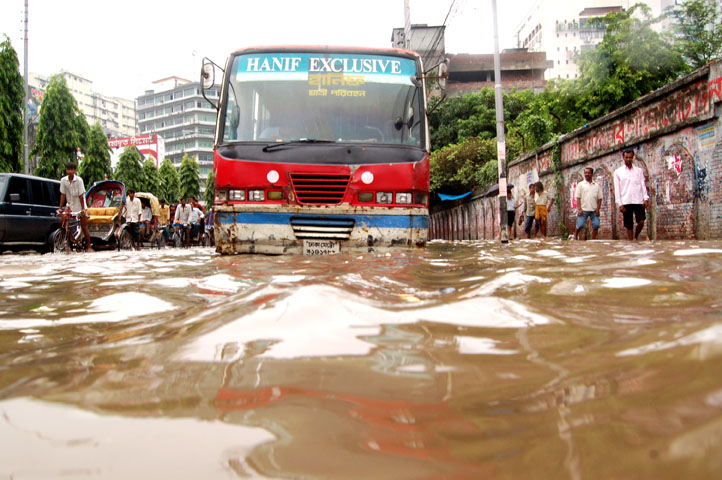
Flooding and urban adaptation
If the economic costs of flooding are high, and cities at lower elevations tend to flood more frequently, why do communities continue to rebuild on the same, flood-prone lands? This blog explores the economic impact of flooding and suggests that aid for reconstruction could be used to encourage economic activity to shift away from flood prone areas.
Floods are among the costliest and most recurring of natural disasters. According to media reports from 1985-2014, floods worldwide killed more than 500,000 people, displaced over 650,000,000 people, and caused damage in excess of US $500 billion.
Other datasets capture even further reaching impacts: according to the International Disaster Database (Guha-Sapir et al. 2015), in 2010 alone 178 million people were affected by floods. Total losses exceeded US $40 billion. To these direct costs we should add longer term costs from disruptions to schooling, increased health risks, and disincentives to invest.
Economic burdens of flooding
It is clearly important to understand why floods affect so many people around the world. One might argue that the risks of floods are balanced by gains from living in flood-prone areas. But as Kydland and Prescott (1977) show, flood plains tend to be overpopulated because the cost of building and maintaining flood defenses is often borne by governments and not private developers.
Worse still, the costs of flood recovery are also often borne by government and NGOs -- a situation rife with the potential for misallocation of resources, and one that raises difficult distributional questions. Such concerns are particularly pressing for developing countries that are disproportionately affected by flooding and where rapid urbanisation is ongoing.
 Flooded streets of Dhaka
Flooded streets of Dhaka
In a recent working paper we study the likelihood of economic activity being concentrated in flood-prone areas, and whether cities adapt to major floods by relocating economic activity to safer areas.
In our empirical analysis, we study the impact of large-scale urban floods. We use new data from spatially disaggregated inundation maps of 53 large floods, occurring from 2003-2008. Each flood displaced at least 100,000 people, and taken together affected 1,868 cities in 40 countries around the globe, mostly in developing countries. We study the local economic impact of the floods using satellite images of night light intensity.
Lower-elevation cities face higher flood risks
Our data shows that the global exposure of urban areas to large scale flooding is substantial, with areas less than 10m above sea level flooding much more frequently. Globally, the average annual risk of a large flood hitting a city is about 1.3% for urban areas that are more than 10m above sea level, and 4.9% for urban areas at lower elevation.
In other words, low lying urban areas face an average annual risk of about one in 20 of being hit by a large flood. Of course, this average masks considerable variation across locations. Local flooding risk results from a complex combination of local climate, permeation, and topography, among other factors.
Some urban areas -- even those at low elevation -- will flood rarely, if ever. At the other extreme, some urban areas flood repeatedly. In our sample, about 16% of cities hit by large floods are flooded in multiple years.
We also find that even though low lying areas are more likely to be flooded, they contain higher densities of economic activity, proxied by night light intensity. This disproportionate concentration of economic activity is consistent even for areas that are prone to extreme precipitation, and where risk of large scale flooding is highest.
Frequent flooding doesn’t cause economic activity to shift
When we analyse the local economic impact of large floods, we find that, on average, they reduce a city's economic activity by between 2 and 8 % during the year of the flood. Stronger effects are observed for areas less than 10m above sea level. Typically lights recover fully within a year of a major flood, even in harder-hit, low lying areas.
Our finding that economic activity recovers after floods, even in low-lying areas, suggests that there is no significant adaptation. Economic activity does not relocate away from the most vulnerable locations. A full recovery, sadly, sets the scene for the next round of flooding.
Many historical cities were built near rivers and coastlines. A possible motivation for restoring vulnerable locations might be taking advantage of trading opportunities and amenity values -- offered by water-side locations. However, we find that economic activity is fully restored even in low elevation locations that do not enjoy the offsetting advantages of being near a river or coast. In any case with efficient modern land transport, the historical benefits of a coastal location may be less important today, while rising sea levels and changing climates are putting more of these cities’ residents at risk of flooding.
One exception to our general finding that cities do not adapt in response to large floods can be found in the subset of recently populated parts of cities (those that had no night lights in 1992). There, flooded areas appear to show larger, more persistent declines in night light intensity, indicating a stronger relocation of economic activity in response to flooding. This may be either because flood risk was under-estimated, and flooding led to updating; or, because newer areas had fewer past investments, so moving away was less costly.
Policy implications
Our results suggest that flooding poses an important challenge for urban planning because adaptation away from flood-prone locations cannot be taken for granted, even in the aftermath of large and devastating floods. This represents an important new contribution to discussions of the costly effects of urban path dependence (Bleakly and Lin 2012, Michaels and Rauch 2013). In particular, our findings suggest that cities and parts of cities, which are built in flood-prone areas, may be locking in exposure to flood risk for a long time, even when circumstances and the global climate change.
Floods disproportionately affect poorer countries. Given the scale of human devastation, and its potential to affect the formation of human capital (for example, disruptions to education or damage to people’s health) this is an important issue for growth and development. In developing countries, planning and zoning laws and their enforcement are often relatively weak. Globally, it is estimated that more than 860 million people live in slums (Marx et al. 2013), which tend to develop on cheap land with poor infrastructure, including flood-prone land.
There are also potential lessons for foreign aid policy. Recovery assistance after flooding is an important part of international aid. Our findings suggest that in some circumstances, part of the aid and reconstruction efforts should be targeted at moving economic activity away from the most flood-prone areas, to better mitigate risks of recurrent humanitarian disasters.
References
Bleakley, H. and J. Lin (2012), “Portage and path dependence,” The Quarterly Journal of Economics, 127(2), 587.
Brakenridge, G. R. (2016), “Global Active Archive of Large Flood Events,” Darthmouth Flood Observatory, University of Colorado.
Guha-Sapir, D., R. Below and Ph. Hoyois “EM-DAT: The CRED/OFDA International Disaster Database,” Universite Catholique de Louvain, Brussels, Belgium. Last accessed on 23 October 2015.
Kocornik-Mina, Adriana, Guy Michaels, Tom McDermott and Ferdinand Rauch, “Flooded Cities,” CEP working paper, 2015.
Kydland, F.E., and E.C. Prescott (1977), “Rules rather than discretion: The inconsistency of optimal plans,” The Journal of Political Economy, pp. 473-491.
Marx, B., T. Stoker, and T. Suri (2013), “The Economics of Slums in the Developing World,” Journal of Economic Perspectives, 27(4), pp. 187-210.
Michaels, G. and F. Rauch (2013), “Resetting the urban network: 117-2012,” Bureau for Research and Economic Analysis of Development (BREAD).

